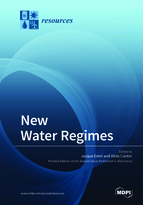New Water Regimes
A special issue of Resources (ISSN 2079-9276).
Deadline for manuscript submissions: closed (15 November 2017) | Viewed by 88738
Special Issue Editors
Interests: mining and development; water resource management; animal geographies, and feminist political ecology
Interests: Water resource management; legal geography; environmental justice; political ecology; feminist science and technology studies
Special Issue Information
Dear Colleagues,
In recent years, the Western United States has experienced severe drought that has stressed the region’s water supply. Struggles to manage water during the recent drought highlight, not only the region’s vulnerability to future climate change, but also shortcomings in the ability of our existing legal system to handle contemporary challenges of water supply and allocation.
Water law in the Western United States is based largely on principles developed over 100 years ago—for example, the doctrine of prior appropriation, or ‘first come, first serve’ water rights. The legal infrastructure governing the region’s water supply was created based upon a certain set of assumptions about water valuation and management: Namely, that the ‘highest and best use’ of water was to be put to use by colonial settlers for economic gain. However, in recent decades, newer political theories, such as eco-feminism, posthumanism, post-anthropocentricism, and decolonialism, have produced different ideas about water valuation and management that conflict with Ameri-Euro imperialist goals and practices. Additionally, newer scientific knowledge, in particular about climate change, has shed doubt upon the ability of existing water rights systems to meet users’ needs in an equitable way as drought becomes the ‘new normal.’
We now find ourselves entrenched in an arguably absurd legal system based on assumptions about water that no longer hold true. The existing water rights system of the Western U.S. is highly antiquated, given new scientific knowledge about climate change as well as pluri-ontological valuation of humanities in natures. In this Special Issue, we seek to reconsider water law from a broad range of theoretical perspectives. Key questions include:
-
How can we re-imagine entrenched water laws inaugurated in a period when capitalists and engineers considered rivers and aquifers nothing but plumbing opportunities to transfer huge volumes of water to agriculture and urban centers especially in arid or semi-arid areas such as the western United States?
-
What should alternative legal structures and principles look like? What must they take into consideration? More broadly, how can we re-imagine civilizations that live with newer knowledges and more pluralistic understandings regarding humans in natures?
-
Recent discourses around re-imagining water rights in NGO and water management circles systems have largely focused on market-based solutions. Why is the market considered the best arbiter, and what alternatives exist?
-
How might existing legal doctrines, such as ‘reasonable use’ be mobilized to rethink existing water rights systems?
-
How do issues such as climate change, food/water security, and food/water sovereignty come into the conversation?
-
How might constitutional reform and political resistance in countries of the south illustrate alternatives to problematic goals and practices embedded in water management in the U.S. West?
While the questions in this issue are framed around a regional focus on the Western United States, we welcome examples from other regions around the world that might provide insight.
Papers will be published in a special issue of Resources, an open access journal that is multi-disciplinary and up and coming. Jacque Emel (Clark University) and Alida Cantor (Berkeley and Portland State University) are the co-editors. Two-paragraph proposals are due 1 August, 2017, and final papers by 15 November, 2017.
Prof. Dr. Jacque Emel
Dr. Alida Cantor
Guest Editors
Manuscript Submission Information
Manuscripts should be submitted online at www.mdpi.com by registering and logging in to this website. Once you are registered, click here to go to the submission form. Manuscripts can be submitted until the deadline. All submissions that pass pre-check are peer-reviewed. Accepted papers will be published continuously in the journal (as soon as accepted) and will be listed together on the special issue website. Research articles, review articles as well as short communications are invited. For planned papers, a title and short abstract (about 100 words) can be sent to the Editorial Office for announcement on this website.
Submitted manuscripts should not have been published previously, nor be under consideration for publication elsewhere (except conference proceedings papers). All manuscripts are thoroughly refereed through a single-blind peer-review process. A guide for authors and other relevant information for submission of manuscripts is available on the Instructions for Authors page. Resources is an international peer-reviewed open access monthly journal published by MDPI.
Please visit the Instructions for Authors page before submitting a manuscript. The Article Processing Charge (APC) for publication in this open access journal is 1600 CHF (Swiss Francs). Submitted papers should be well formatted and use good English. Authors may use MDPI's English editing service prior to publication or during author revisions.







